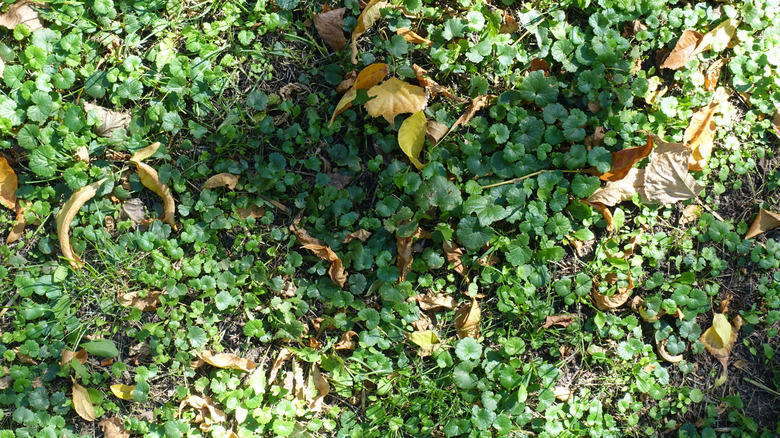Lawn Care Habits That'll Prevent Creeping Charlie From Coming Back
No matter how much time you spend pulling weeds, creeping Charlie (Glechoma hederacea) never seems to truly go away. The invasive species can spread by seed or by runners that grow up to 10 feet long. Since it thrives in anything from deep shade to full sun as well as any soil type, creeping Charlie can quickly colonize the areas where your lawn grass struggles to grow. From there, the evergreen plant can spread into the rest of your yard, eventually outcompeting your grass if left unchecked.
If you want to stop creeping Charlie from coming back, the first place to look is your lawn's health. A dense carpet of healthy grass is the most effective way to keep creeping Charlie and other weeds out. So, if the weed keeps popping up in your lawn, it may be a sign that your grass needs help. Most often, it means the area is too shady or the soil is too poor or compacted for your lawn to thrive.
By diagnosing the problems in your yard, you can modify your lawn care habits to bring your dying lawn back to life and keep creeping Charlie out. For some gardeners, this might be as simple as adjusting your mowing height or changing your irrigation schedule. In other cases, it might require years of soil conditioning or replacing your lawn altogether with a species that's better adapted to the conditions in your yard.
How to keep your lawn healthy and free of creeping Charlie
To figure out which lawn care habits you need to adopt, take note of where creeping Charlie is growing. For example, if it's mainly growing in shade, you likely need to choose a more shade-tolerant species, like fine fescue or St. Augustine, that can better compete with the weed in those areas. Then, find out the best time of year to overseed your lawn with that new species. For areas that get less than 4 hours of direct sunlight, opt for alternative ground cover plants that love shade.
If you already have shade-tolerant grass, your soil might be the problem. creeping Charlie is often an indicator that the soil in that area is compacted or low in nutrients. To fix almost any soil issue, apply a layer of compost at least once a year to improve the structure, drainage, and nutrient density of your soil.
Lastly, check your watering and mowing habits. Frequent watering can leave your lawn vulnerable to disease, heat stress, and drought. Instead, provide all the water your lawn needs for the week in one or two longer sessions to encourage deeper root systems. This will encourage deeper, stronger root growth that makes your lawn more resilient to stress. You can also encourage deeper roots by raising the height of your lawn mower. Longer blades can photosynthesize more energy to fuel root growth while also blocking light and heat from reaching weed seeds in the soil.

